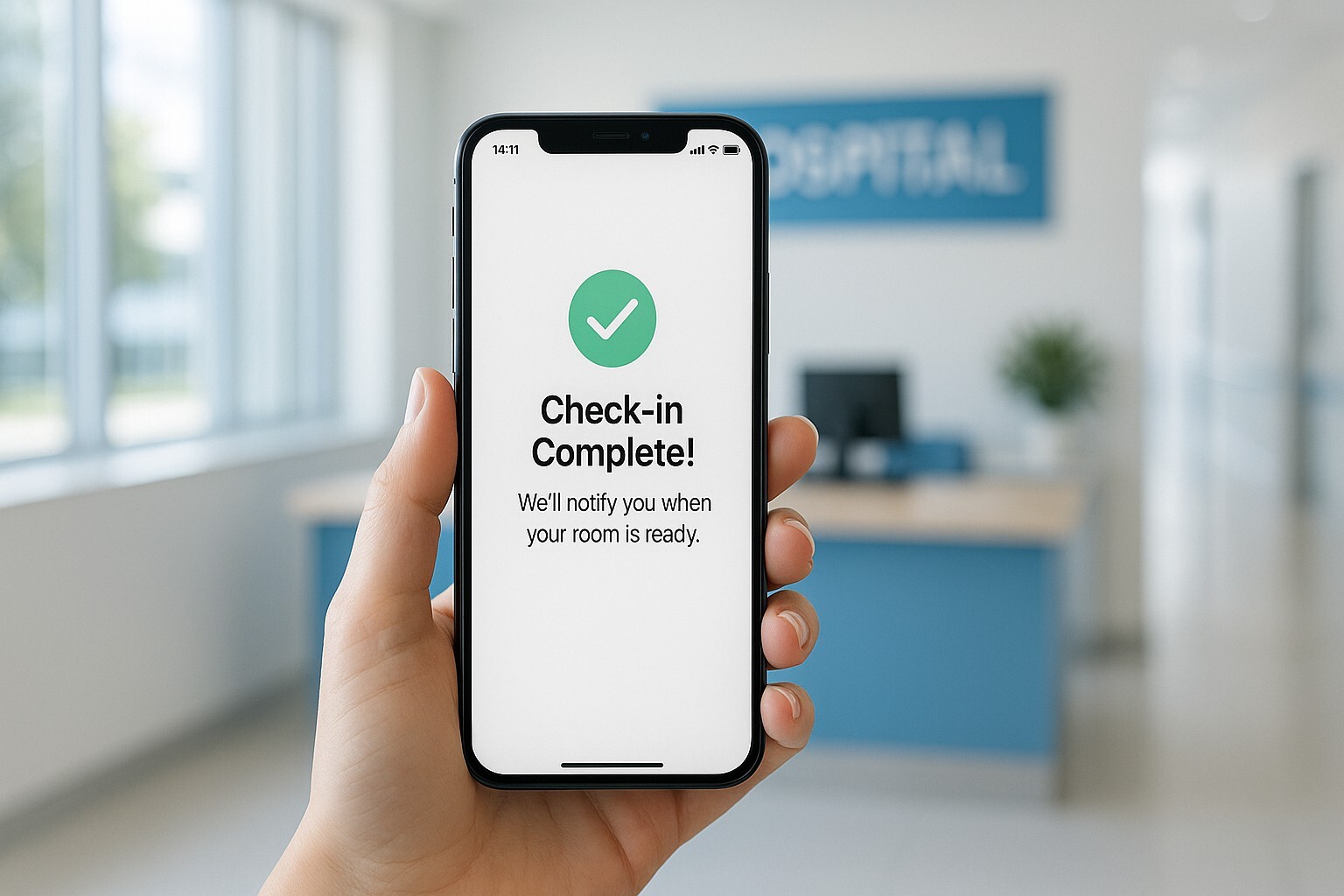The Ultimate Guide to Contactless Patient Check-in and Contactless Hospital Check-in
A contactless patient check-in system allows patients to complete registration, forms, and payments from their own device before arriving,...
9 min read
Alvin Amoroso : 8/4/25 8:07 AM

The modern patient expects convenience, speed, and digital-first experiences in every aspect of their lives—including their healthcare. A digital patient check-in system meets this demand head-on, transforming the outdated, inefficient clipboard-and-pen process into a streamlined, secure, and patient-centric workflow. By adopting an online patient check-in solution, healthcare practices can unlock profound benefits that improve everything from staff productivity and data accuracy to patient satisfaction and the bottom line. This comprehensive guide explores why this technology is no longer a luxury, but a necessity.
For decades, the patient check-in process has remained stagnant, relying on paper forms, manual data entry, and crowded waiting rooms. This traditional approach is a significant source of friction for both patients and administrative staff. The problems are numerous and deeply impact a practice's efficiency and reputation. Patients arrive early only to wait in line, fill out redundant paperwork with the same information they’ve provided before, and then sit in the waiting room while staff manually transcribes their handwriting into the system.
This manual process is notoriously prone to errors. Illegible handwriting can lead to critical mistakes in a patient's medical record, insurance information, or contact details, causing downstream issues like claim denials and communication breakdowns. Furthermore, it consumes an enormous amount of staff time that could be reallocated to more valuable, patient-facing tasks. The administrative burden of printing, scanning, shredding, and manually entering data is a hidden cost that drains resources and slows the entire clinical workflow to a crawl. In an era of digital transformation, clinging to the clipboard is not just inefficient; it's a competitive disadvantage that compromises patient care and satisfaction.
A digital patient check-in system is a technology solution that allows patients to complete their intake forms, update medical history, verify insurance, and even make co-payments electronically before their appointment. This online patient check-in process is typically initiated when the practice sends a secure link to the patient via email or SMS a few days before their scheduled visit. Patients can then use their own device—a smartphone, tablet, or computer—to complete all the necessary paperwork from the comfort of their home or on the go.
From the practice's perspective, the process is seamless. As the patient completes the forms, the information is automatically and securely integrated into the practice's Electronic Health Record (EHR) or Practice Management System (PMS). This eliminates manual data entry, reduces the risk of human error, and ensures that the patient's file is complete and up-to-date before they even walk through the door. This fundamental shift from a manual, in-office task to an automated, pre-appointment workflow is the core of what makes the digital patient check-in so transformative for modern healthcare.
Adopting an online patient check-in solution provides a cascade of benefits that ripple through every part of your organization. It’s a strategic investment that enhances operational efficiency, financial health, and the quality of patient care.
A digital patient check-in system is one of the most effective tools for reducing frustrating and unnecessary wait times. By allowing patients to complete all administrative tasks before their visit, you eliminate the single biggest bottleneck in the pre-appointment workflow. When a patient who has completed their online patient check-in arrives, their interaction at the front desk is reduced to a simple, quick confirmation, allowing them to be seen by the clinical staff almost immediately.
This not only creates a more pleasant experience for the patient but also helps keep the entire day's schedule on track. Reduced wait times lead to higher patient satisfaction scores, better online reviews, and a calmer, less crowded waiting room environment. It sends a clear message to your patients: you value their time as much as your own.
An online patient check-in platform ensures that the data entering your EHR is accurate, complete, and legible. When patients enter their own information directly into a digital form, it eliminates the errors and ambiguities that arise from staff trying to decipher messy handwriting. This direct-to-system data flow minimizes the risk of typos and transcription mistakes that can lead to serious issues, such as incorrect diagnoses, billing errors, and denied insurance claims.
Furthermore, digital forms can be designed with required fields, ensuring that no critical information is accidentally omitted. Patients have more time and privacy to carefully review and update their medical history, allergies, and current medications, leading to a more comprehensive and precise medical record. This foundation of accurate data is crucial for delivering safe and effective care.
Implementing a digital patient check-in process liberates your front-office staff from the repetitive, low-value tasks of managing paper forms. With automation handling the data entry, your administrative team is freed up to focus on higher-impact activities that improve the patient experience. This includes greeting patients warmly, managing complex scheduling issues, answering detailed questions about insurance, and providing personalized assistance to those who need it.
This shift doesn't just make your staff more productive; it also improves their job satisfaction by allowing them to engage in more meaningful work. Instead of being data-entry clerks, they become true patient advocates and relationship builders. This increased efficiency means your practice can handle a higher patient volume without needing to expand administrative headcount, directly improving your operational leverage.
The patient experience begins long before a patient sees a doctor, and a seamless online patient check-in sets a positive tone for the entire visit. Offering the convenience of completing paperwork on their own time and device shows respect for the modern patient's busy lifestyle. It removes the stress of rushing to an appointment just to fill out forms in a hectic waiting room.
This patient-centric approach fosters a sense of control and engagement, making patients feel like active partners in their own care. The positive impression created by a smooth, tech-forward check-in process carries through the rest of the visit, contributing to greater patient loyalty and a stronger practice reputation. To further improve your practice's service, you should read our guide on improving the overall patient experience.
A key feature of a robust digital patient check-in system is the ability to integrate payment collection into the pre-appointment workflow. The platform can automatically verify insurance eligibility in real-time and present the patient with a clear estimate of their financial responsibility, including co-pays and outstanding balances. Patients can then securely make payments online as the final step of their check-in process.
Collecting payments upfront is significantly more effective than trying to collect after the patient has left the office. This method improves cash flow, reduces the costs associated with mailing paper statements, and decreases the amount of revenue lost to bad debt. It also provides price transparency, which patients increasingly expect and appreciate.
The costs associated with a paper-based check-in system are often underestimated but add up quickly. These include the direct costs of paper, ink, toner, printers, clipboards, and file storage, as well as the indirect labor costs of printing, scanning, shredding, and manual data entry. Transitioning to a digital patient check-in solution virtually eliminates these expenses.
By going paperless, your practice not only saves money but also reduces its environmental footprint. This move streamlines your office, frees up physical space previously used for document storage, and creates a more modern, organized, and efficient front-office environment. The return on investment from these cost savings alone can often justify the implementation of the system.
A digital patient check-in system offers far greater security for protected health information (PHI) than paper forms. Paperwork left on counters, clipboards passed around a waiting room, or documents waiting to be shredded are all significant HIPAA compliance risks. Digital solutions encrypt patient data both in transit and at rest, ensuring it is protected from unauthorized access.
Reputable online check-in platforms are designed with HIPAA regulations at their core, featuring safeguards like secure servers, access controls, and audit trails. According to government resources like HIMSS (Healthcare Information and Management Systems Society), robust digital security is paramount. By digitizing the intake process, you minimize the physical handling of sensitive information, drastically reducing the risk of a data breach and demonstrating a firm commitment to patient privacy.
The benefits of a digital patient check-in extend beyond the front desk and deep into your clinical workflows. When patient data is complete, accurate, and available in the EHR before the appointment begins, clinical staff can prepare for the visit more effectively. Nurses and medical assistants can review the patient's updated history, chief complaint, and medications in advance, allowing them to have a more focused and productive conversation once the patient is in the exam room.
This pre-appointment data availability means less time spent by clinical staff on administrative data gathering and more time dedicated to direct patient care. This efficiency gain helps keep doctors on schedule, reduces patient time in the exam room, and allows the entire care team to operate more cohesively.
Digital intake platforms are powerful data-gathering tools that can provide valuable insights into your patient population and practice operations. These systems can track key metrics such as patient wait times, form completion rates, and patient satisfaction scores. This data allows you to identify bottlenecks, measure the impact of operational changes, and make data-driven decisions to continuously improve your services.
You can also use the platform to administer patient-reported outcome (PRO) surveys or customized questionnaires to gather specific clinical or demographic data. This information can be used for population health initiatives, marketing efforts, or quality improvement projects, turning the routine check-in process into a strategic asset.
In the age of telehealth, a robust online patient check-in process is absolutely essential. For a virtual visit to be efficient, all administrative and clinical intake tasks must be completed remotely beforehand. A digital check-in system provides the perfect framework for this, ensuring that the provider has all the necessary information and that co-pays are collected before the virtual encounter begins.
This seamless pre-visit workflow makes the telehealth experience smoother for both the patient and the provider. It ensures that the limited time on a video call is dedicated entirely to clinical care, not administrative formalities. As virtual care becomes a permanent fixture in healthcare, having a solid digital intake strategy is critical for success.
In today's competitive healthcare market, patient experience is a key differentiator. A practice that offers modern, convenient, digital tools stands out from those still relying on outdated methods. Implementing an online patient check-in solution signals that your practice is innovative, efficient, and dedicated to patient-centric care.
Positive experiences lead to positive online reviews, strong word-of-mouth referrals, and increased patient loyalty. By investing in technology that meets the expectations of today's digital-savvy consumers, you not only improve your operations but also build a powerful brand reputation that attracts and retains more patients, securing your practice's long-term growth and success.
Transitioning to a digital workflow requires careful planning and execution. Following a structured approach ensures a smooth implementation for both your staff and your patients.
Yes, in most cases, a legal guardian, parent, or healthcare proxy can complete the online patient check-in on behalf of a patient. This is a common and essential feature for pediatric practices or for patients who may be elderly or unable to complete the forms themselves. The system will typically have a designated section to clarify the relationship of the person completing the forms to the patient, ensuring legal and ethical guidelines are followed.
The patient check-in process encompasses all the steps a patient must take between arriving for their appointment (or preparing for it from home) and being seen by a clinician. Traditionally, this involves signing in, presenting an ID and insurance card, and filling out paper forms. With a digital patient check-in, this process is transformed. It typically includes receiving a link pre-appointment, electronically verifying demographic information, updating medical and social histories, signing consent forms, and making co-payments, all from a personal device before the visit.
A patient self-check-in system is a broad term that includes both online patient check-in (completed before the visit) and in-office solutions like check-in kiosks. The core concept is empowering the patient to manage their own intake process without relying entirely on front-desk staff. While kiosks can help reduce lines at the front desk, pre-visit online check-in is generally more efficient as it removes the task from the office environment entirely, preventing waiting room bottlenecks.
While related to patient engagement, patient portals are distinct from dedicated check-in solutions. The two main types of patient portals are:

A contactless patient check-in system allows patients to complete registration, forms, and payments from their own device before arriving,...

The single biggest opportunity to reduce staff workload and improve patient satisfaction lies in the first five minutes of a patient's visit. A...

The first few minutes a patient spends interacting with your practice can define their entire experience. A clunky, slow, and confusing medical check...